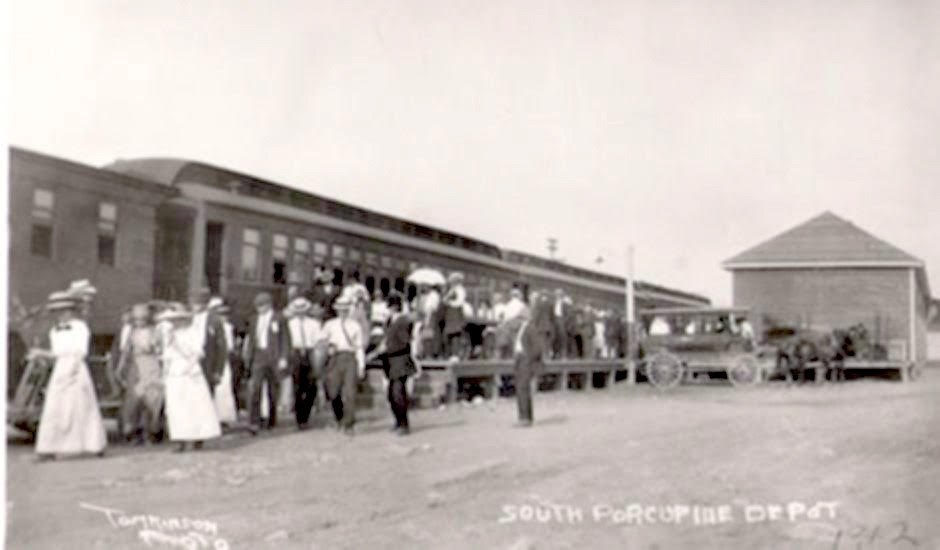Snaking its way through the dense bush, the railway was vital to the development of mining, forestry and communities across Northern Ontario in pioneer times.
The Temiskaming & Northern Ontario Railway (T&NO) was incorporated as a provincial agency in 1902 after the government realized it was needed to reach wealthy mineral deposits and a vast timber supply.
It should come as no great surprise that development in the north usually took place close to the T&NO. By 1905, the rail line reached New Liskeard. It reached Englehart in 1906 and Cochrane in 1909. The railroad line reached Timmins on Jan. 1, 1912, but didn’t make it all the way up to Moosonee until 1932.
The T&NO was a catalyst for action in all parts of northern life.
For example, Timmins’ famous prefab Hollinger Houses were shipped north on the T&NO from New Liskeard in 1919. Local troops returning home from two world wars were greeted by families, friends and entire communities at train stations. Supplies came north, while gold and lumber went south. It also provided service to the Abitibi Canyon Generating Station, which was built in the 1930s.
The T&NO also was home to one of the great legendary characters of the early days in Northern Ontario. George W. Lee was the general manager of the railroad and the chairman of the T&NO Commission.
In May 1929, the Porcupine Advance rain a story, which was originally published in Toronto Saturday Night, that had become the talk of the town in Timmins.
“The vast, unknown north, with its hidden riches of untold proportions, was to be opened up. And George Lee was on the scene. Then he was the only claims agent for the new railway. Today he is the general manager of the system and the chairman of the T&NO Commission, a position which he has filled with characteristic efficiency and tremendous energy for the past 10 years, during which time the railway has been placed on a paying basis in addition to having opened up New Ontario.
“George Lee was on the scene again that eventful day a year or so later when the steam shovels operating one hundred miles north of North Bay began to root up masses of silver and the famous Cobalt silver camp sprang into being almost overnight. And down through the years he has been a silent partner of the mining men and the timber magnates who have sought to open up the fastnesses of the North and bring its fabulous wealth into active production.
“George Lee was on the job when the urgent call came for a spur line into the newly discovered gold territory in the Timmins and Porcupine districts, the paper-making industry at Iroquois Falls found in him a ready and willing co-operation; under his guidance the T&NO has steadily pushed its way northward until today it is only 80 miles from James Bay, a new land of promise and opportunity.
“George Lee was on hand to rush railway facilities for the mining camps. The people of the North Country will recall the many occasions when George Lee and his railway came to the rescue of the countryside in its hour of peril, how when raging forest fires swept the country, whereby hundreds of lives were saved and the sufferings of many other hundreds assuaged.”
Lee was also well known for his sense of humour. He was a friend of Ontario Premier Howard Ferguson and took the politician on a tour of the north via the railroad. Lee’s humour created quite a stir during the trip, according to the article.
“One morning they visited a small school in one of the rugged settlements along the T&NO where the premier had promised to stop. The young lady teacher. having only seen the premier in picture and caricature prior to this time, advanced quite assuredly upon the general manager of the T&NO and address him: ‘We are so glad to welcome you Mr. Premier. The children have been eagerly awaiting your arrival and I would ask you if you would now say a few words to them.’
“Thereupon the pseudo premier took the platform, offered a word or two of encouragement to the youngsters and generously, and amid thunderous applause, gave them a holiday for the remainder of the day, all the while Hon. Mr. Ferguson looked on with astonishment at the highly successful impersonation perpetrated by his host.”
The Temiskaming & Northern Ontario Railway had a name change to Ontario Northland Railway in 1946. Part of the reason was to remove confusion created by its initials, which were the same as the Texas & New Orleans Railway. It was also believed the name change created a provincial brand, rather than a regional one.
Growth continued for the ONR as spurs were built for mines in Temagami, Kirkland Lake and Timmins in the ‘50s and ‘60s. The ONR later, in 1993, bought additional sections in Northern Ontario from Canadian National, which were once part of the National Transcontinental Railway.
Even though highway systems linking the north and south improved over the years, passenger rail service remained popular, particularly when Northerners could travel overnight to the Toronto area arriving in the morning in time for medical and business appointments.
Passenger service on the ONR — The Northlander — made its last trip south on Sept. 28, 2012. The Northlander was replaced by bus service, despite protests by communities across Northeastern Ontario. The move was made by Dalton McGuinty’s provincial government as a cost-cutting measure. Passenger rail service continued to operate from Cochrane to Moosonee on the Polar Bear Express.
In recent years, there have been discussions about re-establishing The Northlander passenger service, although there has been no firm commitment from the provincial government.
